Homework: Workbook Chapter 17 pg 139 a,b,e 141 #1 // 147 # 2//148#6//150#8
Homework: Workbook Ed 4 Chapter 18: pg 151-152 c,d,e 153 #2, 162#8, 166#11
About The Quiz:
The quiz will be in two parts. The first part will be sight singing in minor only. You will need to prepare all of SS07 and will be asked somewhat randomly to sing one line from that worksheet.
The second part will be written. It will cover chapters 16 & 17. Diatonic Sequences are critical to your understanding of harmonic function. For those of you that want to pursue composition, Sequencing is one of the cornerstones to harmonic, melodic, and rhythmic expansion. Many of the Diatonic sequences that we discussed in class originate from the concepts presented in chapter 16. If you understand chapter 16 than you have a solid foundation on which to base your understanding of Diatonic Sequences. These webnotes and the text present the most common harmonic diatonic sequences. You should know these by name, know how to construct them and understand what they sound like. If I ask you to build a 5-3/6-3 variant of a perfect sequence of Ascending 5ths in the key of F, you should feel comfortable doing so.
Compositional Functions
1. Repetition
a. One of the most critical elements of musical design and form is repetition of a melodic or chordal pattern. If such repetitions occur on different scale degrees, the result is called a sequence.
2. Sequences and transitional passages
a. Passages that contain sequences have a tendancy to to move continually forward as the passage repeats through its sequence. This tendancy makes sequential passages excellent choices for "connective tissue" between more stable elements of a composition. In its most basic 3 part form a passage might contain the initial establishment of a tonic, a sequential passage that perhaps develops that initial statement, and a cadential resolution to the passage. Some examples of such sequential use include episodes between fugual subjects, transitions in sonata expositions and virtuoso passages in concertos. In more diverse forms such as the Rondo, one sometimes find significant sequenctial passages as primary material of interior sections.
3. Diatonic Progressions
a. For now, we will only discuss the most common diatonic sequences (sequencing occring naturally in the given key) using 5-3 and 6-3 chords
4. Classification of sequences
a. Sequences with descending 5ths
b. sequences with ascending 5ths
c. Sequences using ascending 5-6 technique
d. sequences falling in 3rds (descending 5-6 technique)
NOTE: I like to make a distinction between two types of sequences. In previous chapters we have seen repeated patterns such as progressions based on a 5-3 bass line descends in 5ths. This type of progession has a harmonic, chordal repetitive pattern and has a tendancy to move continually forward. However if you review the examples in the web notes, you will see that the voice leading of these patterns yields varying intervalic relationships between any given voices on any given beat. This type of sequence; one that fufills that has sequential elements yet does not repeat itselff in such an intervalic manner I call an IMPERFECT SEQUENCE.
In this chapter, we will look at a number of sequences that not only have the above described sequential elements, but also maintain a consistant intervalic relationship between all voices from one sequential step to the next. These types of sequences I call PERFECT SEQUENCES.
5. Voice Leading Implications
a. When a sequential passage is based on strong harmonic foundations, those foundations will carry a weight that will, in many cases, contradict our now familiar rules of voice leading. This will be particularly true of sequences in which all voices participate in the repetitive pattern. ¶5 & ¶8 will tend to appear more readily within a sequential passage. As such, voice leading chords may be inserted within the sequence to promote better movement within the sequence. As well, doubled ^7ths may appear and as long as they dont lead to a final tonic. If we consdier a tonic I chord within a sequence has resulting from the sequenctial pattern and not acting as a cadential element, we do not have to consider the ^7 preceding such a tonic as a leading tone. As well, diminished 53 chords, which we have until now avoided, may be acceptable if they are part of the sequenctial pattern.
Sequences with Decending 5ths
6. Harmonic and contrapuntal implications
a. We saw in chapter 16 that we could build a 53 progression around a bass line descending in 5ths (or rising in 4ths). This sequence will often move its bass in patterns such as down 5th-up 4th or visa versa and may contain a consistant relationship with the other voices.

7. 5-3/6-3 pattern
a. If we take our decending 5th sequence above and modify the every other shord so it appears as a 6-3 instead of a 5-3 we derive an alternative to the descending 5-3 in 5ths sequence. This sequence adds additional interest and harmonic variety to the common descending 5ths sequence. One may easily reverse the sequenctial pattern and begin on a 6-3 and alternating with 5-3.
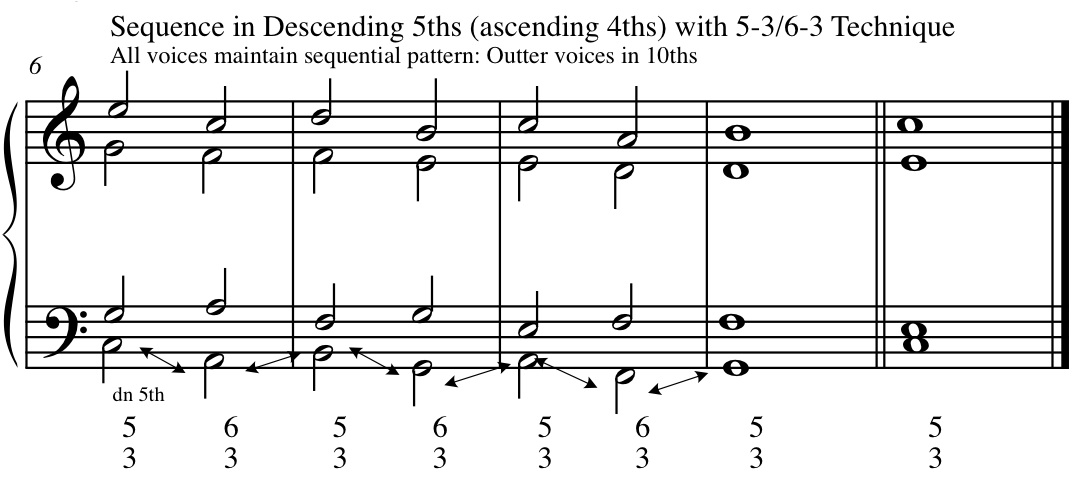
Sequences with Ascending 5ths
8. Harmonic and contrapuntal implications
a. Like the descending 5th sequence, The Ascending 5ths sequence is created from the same logic we saw in the usage of ascending 5ths in a 5-3 progression. (Review webnotes 06). In the case of a sequential passage of ascending 5ths each pair of chords often supports a soprano line that descends by step.
9. Omitting a step in the ascent.
a. Like the progression in 5-3 position, the sequence of Ascending 5ths has a rather stark tritone between ^7-^4 (VII) in Major and ^2-^6 (II) in minor. Often we see composers simply skipping over these sequential steps thereby avoiding the unwanted tritone.
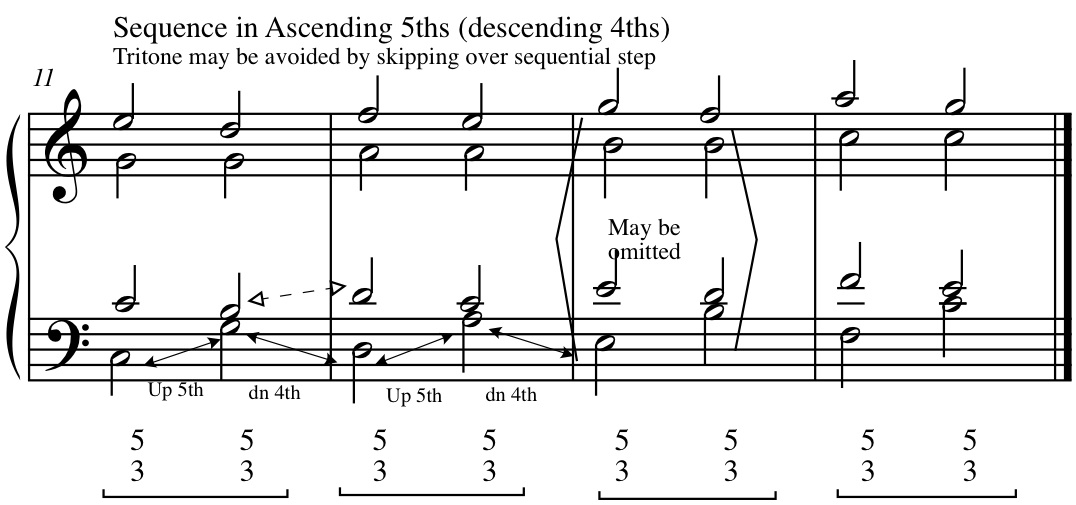
10. 5-3/6/3.
a. As with decending 5ths, an ascending 5ths sequence may have a 5-3/6-3 or 6-3/5-3 variant. Like the 5-3 progression, the 5-3/6-3 variant will sometimes skip the sequential step containing the tritone.
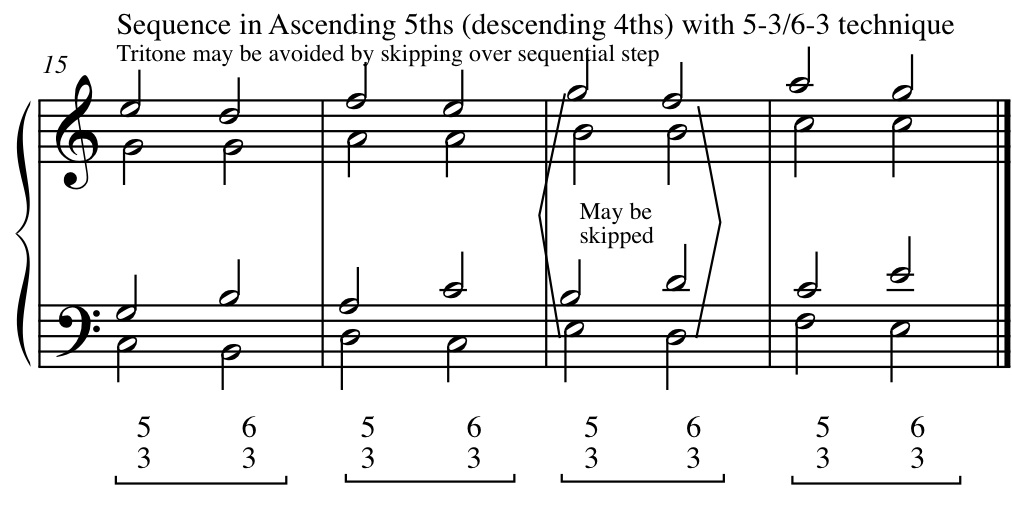
11. Syncopes
a. At various times throughout the year, we have seen the interrelated use of 5-6 and 6-3 chords. We have seen that most any chord can function similarly in 5-3 or 6-3 position and we have seen that above a given bass, the 5-3 chord is very closely linked to the 6-3 with one often substitiuting for the other (remember the use of IV and II6) We can further elaborate on the concept of 5-3/6-3 sequences by allowing the free sequential movement between a 5-3 and 6-3 chord over any given bass. When such movement extends over a demonstrated bass pattern, such a progression is sequential.

12. 5-3 Variant of ascending 5-6 (syncope)
a. If we transform the 6-3 chords of the Syncope into 5-3 chords over a lowered third bass we get a very interesting root poisition sequential variant of the ascending 5-6 sequence.
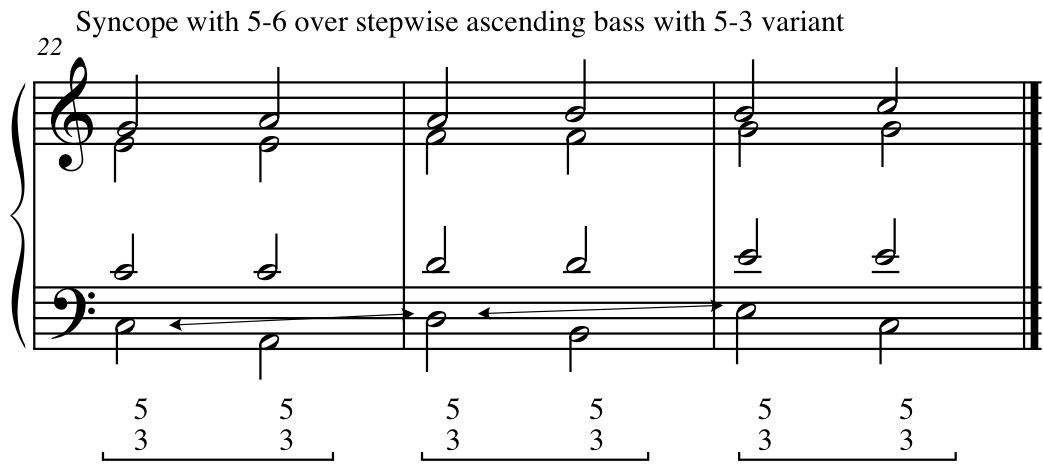
Sequences Falling in 3rds (Descending 5-6)
13. Harmonic and Contrapuntal implications
a. When a 5-6 sequence occurs over a bass that descends by step, each sequential segment occurs a third lower than the previous one.
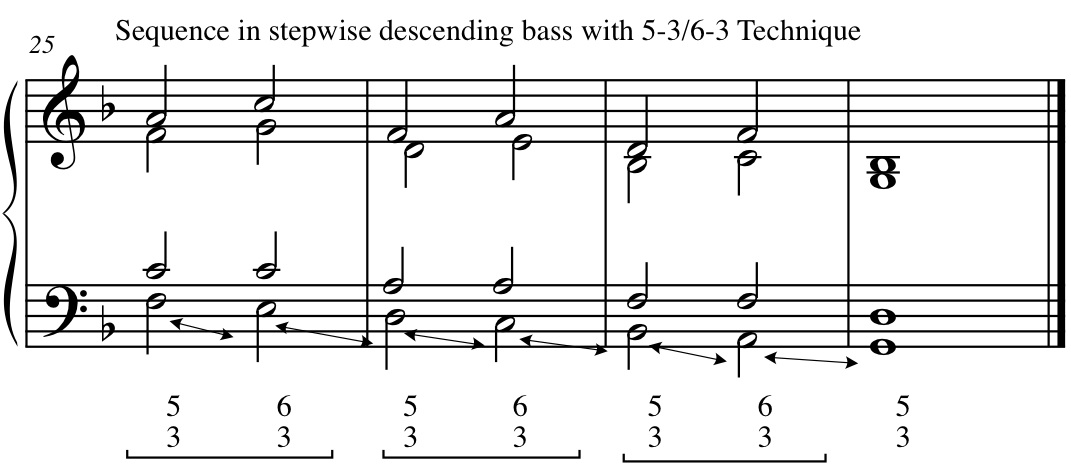
14. Root position variation of descending 5-6
a. If we revoice each occurance of the 6-3 in the Descending 5-6 sequence such that it becomes a 5-3 we get a root position variation of the descending 5-6 sequence.
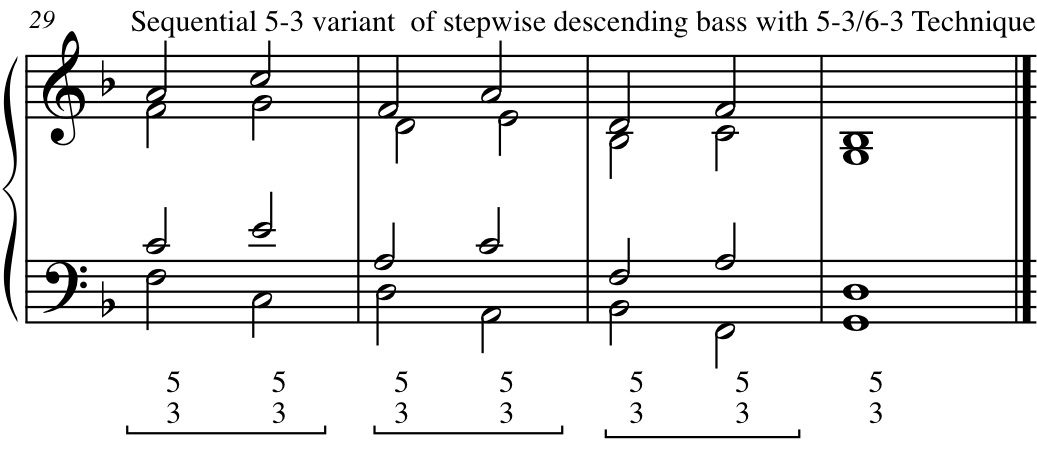
Less Frequent Sequential Patterns
15 Ascending by step with voice-leading 5-3 chords
a. This sequence is built on a stepwise 5-3 bass line. Since such a bass would likely yield problematic voice leading subject to many ¶s, we may interpolate "Voice Leading Chords" (see theory2_notes_06). In this example the voice leading chords are derived as ascending 4ths (descending 5ths) from the origin
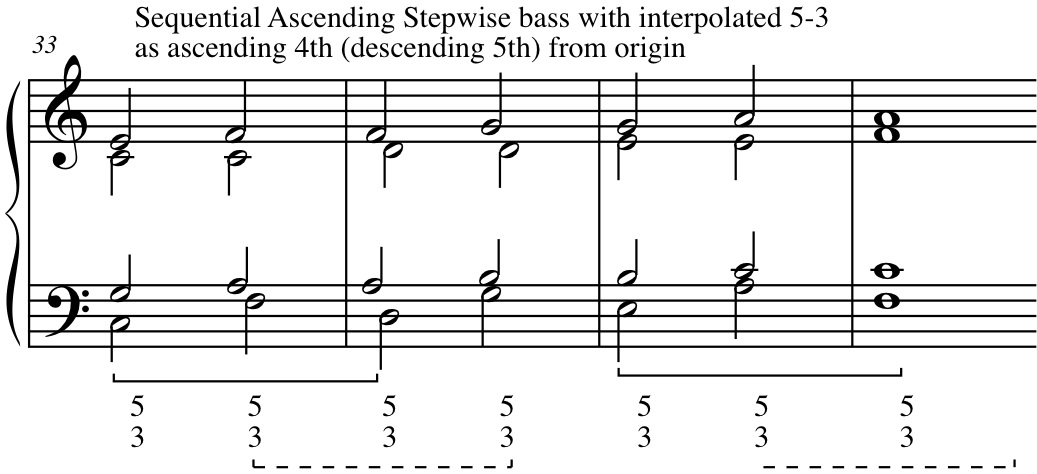
16 Syncope with 6-3/5-3 over stepwise descending bass
a. When the interval succession contracts from a 6-3 to a 5-3 over a bass tone we achieve a descending syncope.

Sequences Moving to Tonicized V
Note: H&VL dedicate a relatively small amount of the text to this very important concept. If you recall, a successful modulation or tonicization to the Dominant V requires a "pivot" chord followed by an "applied dominant". Our reasoning for the importance of the pivot chord is that it exists in both the old tonic key and the new - modulated - dominant key. Equally important is the fact that the pivot chord very subtly draws the ear away from the tonic and leads the ear towards some other harmonic center. The further the ear is drawn away from the original tonic, the more accepting it may be towards some new key area be it the dominant or a modulation to any other key. The expansive and repetitive nature of sequences provide a satisfying means by which the ear can be pulled towards that new key area. The repetitive nature of a sequence, when used motivically, can actually strengthen the compositional material as the ear travels towards the desired destination. Please note the significance of sections 17 and 18 below
17. Descending 5-6 leading to a tonicized V
a. Here we have a descending stepwise bass with a 5-3/6-3 sequence very similar to #13 above. However, in this example, the last iteration of the 5-3 chord contains a raised ^4. Here the raised ^4 acts as the new leading tone as the final sequential step becomes an applied dominant to V.
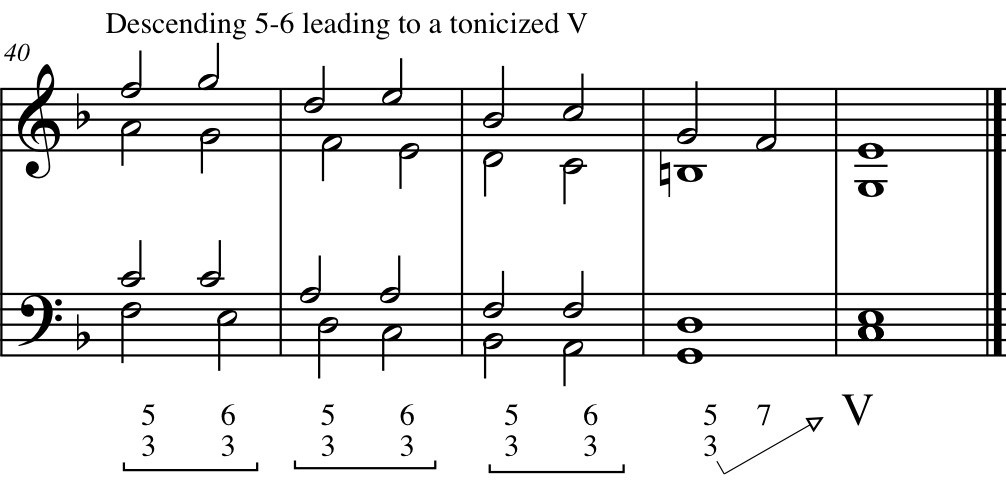
18. Ascending 5-6 leading to a tonicized V
a. In this example the Syncope with a 5-6 ascending bass is used to move us towards a tonicization of V. If the sequential pattern begins on the I chord, the II chord will appear too early to function as a convincing applied dominant to V since the ear has not been led far enough away from the original tonic. Study the Syncope 5-6 and realize that the II chord appears on the 2nd interation of the sequence. In this example, a quick I-V-I establishes the key and then the sequence starts on a II5 and proceeds utnil the chromatic alteration of the final 6-3 yields an applied dominant.
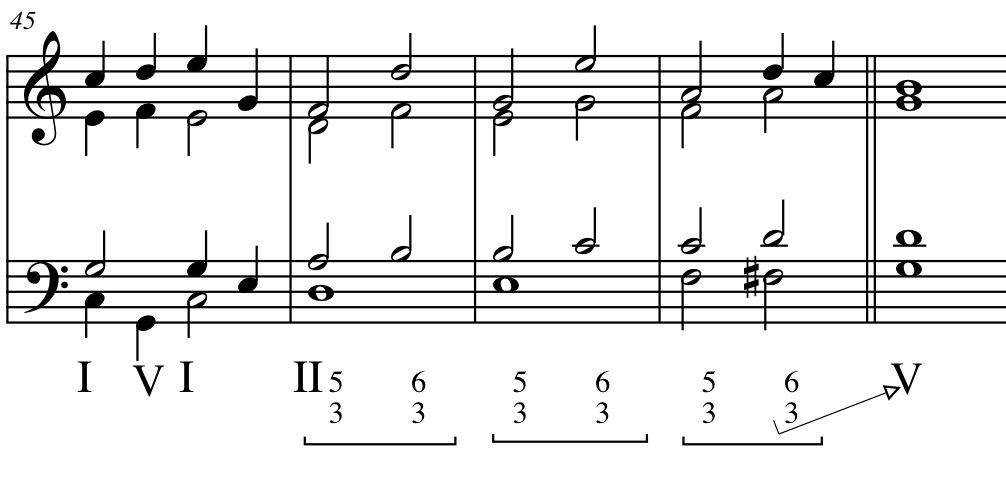
Note: This principle of a sequential passage leading to applied dominance and modulation is not restricted to just the two examples above. Infact, one may apply this principle to not only all of the examples within these notes and the text but also to various other sequences we will see in the coming semesters.
Sequences in Minor
19 - 22. Descending & Ascending motion
a .In class I have played various sequences in both major and minor. In doing so, I was careful to play those that worked best in either mode. Indeed, many sequences work well in either mode but, just as we saw in chapter 16 that the first half of the ascending 5ths pattern works best in Major and the second half works best in minor, so too will certain sequences tend to have more convincing sequential steps in one mode than the other. As well, when sequencing in minor, one only need be concerned about raising the ^7 when it functions as a LT.
b. H&VL states that ascending from V in a diatonic sequence is unusuable. Please note that this assumes that you are transforming the sequence into melodic or harmonic minor and therefore this is really not a statement about sequences that are diatonic to natural minor. Since we hold true their ascertation that one only be concerned about raising the ^7 when it functions as a LT, we can, for the most part disregard this section 22 in H&VL
Let your ear be the final judge but remember, if something bothers you in a sequential passage, especially in minor, look first to the tritone. If it tends to resolve incorrectly that may be the culprit. If you determine that the tritone is not the problem look for A2nds and d5ths in your voice leading.
Nomenclature for Sequences:
1. Standard sequence
a. Direction of Bass line + Interval of the Bass line
1. "Descending 5ths"
2. "Ascending 5ths"
3. "Descending Stepwise bass"
4. "Ascending Stepwise Bass"
\
2. Variation
a. Type of Variant
1. Syncope
2. 5/3-6/3 Variant
3. 6/3-5/3 Variant
4. 5/3 Variant
3. Alteration
a. Suspension
1. 7-6
2. 4-3
3. 9-8
b. Chord alterations
1. Alternating inversions of 7ths chords
Stated: Variation "of" Standard Sequence "with" Alteration
a. "6/3-5/3 Variant" - of - "Descending 5ths Sequence" - with- a "9-8 Suspension"
|

